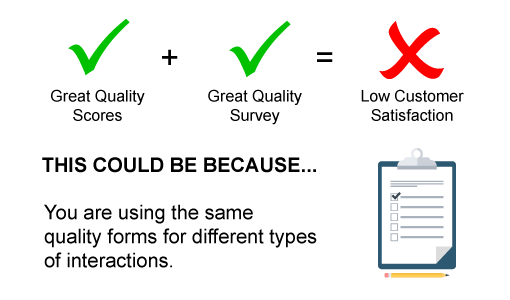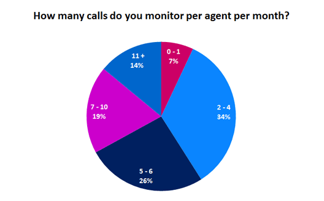1st February 2017

Call quality monitoring plays a key role in ensuring customer interactions meet both business standards and customer expectations.
By focusing on high-impact behaviours, agent engagement, and consistent feedback, businesses can drive continuous improvement.
In this article, we share 30 expert tips and strategies to help you strengthen your call quality monitoring approach.
The aim of quality monitoring from an operational point of view is to identify the calls failing to meet predefined standards and get to the root cause of why. You can then make informed decisions to make the process better, faster and quicker.
For example, implement or refine agent training and coaching initiatives to bridge skills gaps, correct broken internal processes, improve workforce scheduling, or perhaps alert other areas of the organisation that are having an impact.
To achieve this, you need to be able to evaluate a representative sample of interactions. The smaller the sample, the less accurate your benchmark scoring will be, and you will run the risk of making the wrong decisions.

Here is an idea which has been used in my centre. We have a programme which we call a ‘coffee morning review’.
It’s a weekly programme, attended by an operation manager, a quality assurance officer, a team leader, a supervisor and five agents.
We do ‘hearing tapping’/ listening to a recording (any subject: information, inquiry, or complaint) and then we discuss the agent’s recording based on the procedure. It works almost 100% of the time.
An agent who was invited to the programme wouldn’t be invited again the next week because he/she has been progressing well in giving great service (quality and service attitude).
Contributed by: Craig Pumfrey, VP of Marketing, Sabio

Call monitoring is often costly and manual, so it’s not practical to evaluate every interaction equally. Focus instead on the outliers, both the lowest and highest performers.
Top performers provide valuable insights into best practices and behaviours that drive results. Meanwhile, focusing on low performers helps raise the overall quality and improve outcomes.
Contributed by: Ed Creasey, Director Consulting, NiCE
The more detailed our understanding of key behaviours, the better we can help agents improve.
By identifying and reinforcing high-yield behaviours, such as script adherence, reducing customer and new-hire attrition, high NPS techniques, efficient handling time, and effective sales conversations, we can drive significant results.
Here is a list of high-yield behaviours that you can look to reinforce:
Contributed by: Martin Hill Wilson, Director, BrainFood Consulting
For more great tips and techniques for contact centre selling, read our article: Top Tips for Selling Over the Phone
One effective approach is to select a theme of the month for each agent based on their call recordings. This theme can focus on a soft skill like pitch, tone, or empathy, or a technical area such as information accuracy or system usage.
Focusing on a single point each month helps agents develop better habits over time. After the month ends, review their progress and decide whether to continue with the same theme or move on to a new one.
This method prevents overwhelming agents and provides clear focus for continuous improvement.
Contributed by: Kiryn, a Call Centre Helper reader
Engage your team in developing the quality monitoring process so they understand it, buy into it, and contribute to it.
Collaboratively creating a checklist of areas to improve allows agents to share what they feel needs attention. This helps you focus on those areas when monitoring calls.
Involving agents in this way increases the credibility of the process and boosts their willingness to change, making quality monitoring more effective.
Contributed by: Andrew, a Call Centre Helper reader
When reviewing monitored calls with agents, avoid giving direct instructions on how to improve. Instead, let agents listen to their own calls, reflect on their performance, and ask questions. This encourages them to identify development areas themselves.
Larry Skowronek at NICE believes that this is a good idea. He states that when the agent and the coach go into their meeting, because you’re dealing with all their interactions, the agent doesn’t have the ability to say ‘you happen to have found the one case where I did that, but it only happened once’.
So it removes the ability to blame sample size and allows the coach and the agent to become much more collaborative” and makes it easier to identify areas for improvement.
Contributed by: Rebecca, a Call Centre Helper Reader

Another idea that involves agents when quality monitoring is to include an agent in the process of monitoring another team’s calls.
This approach helps agents feel involved rather than just being spoken at, fostering a more positive mindset and deeper connection to quality monitoring.
For many of us, quality forms have become a façade of delivering great service.
It’s about building habits that are going to become second nature to the team and allow them to deliver the best possible customer experience, which meets all of your needs as an organisation.
I believe, fundamentally, that quality should be about two things: foundation, whether or not we are doing something, and finesse, how well we do it.
Contributed by: Martin Hill-Wilson

Agents handle different types of calls, inbound, sales, outbound service, so each call type should have its own tailored quality form.
Here is a story to show this point:
A contact centre had just put in great customer satisfaction programs and quality program. But, here’s the challenge, on the CSAT scores, customers were rating very poorly, however quality scores couldn’t be better.
Upon review, it was found to be one of the best surveys and quality forms seen. Then the question was asked ‘do you handle a bunch of different types of interactions with your organisation? Are you using this form for all of them?
The answer was yes. Looking into the quality trends, it was noticeable that there was a disconnect.

This was found to be due to the CSAT scores of the group of agents responsible for calling people and telling them they were denied for mortgages.
No wonder the customer satisfaction was low, they aren’t happy because they aren’t getting what they wanted. But from a quality standpoint, there’s not much else that agents can do.
Contributed by: Justin Robbins, Founder & Principal Analyst at Metric Sherpa
Gaining agent engagement early in the monitoring process is essential. When monitoring is first introduced, some may see it as critical or punitive. Over time, if left unchanged, others may begin to ignore it altogether.
Call quality monitoring shouldn’t be a top-down tool to trip agents up, it should be part of a wider skills programme that benefits both agents and customers.
A collaborative, inclusive approach leads to greater buy-in and cooperation, especially when agents understand what’s expected of them and how their calls impact the business.
Feedback from call monitoring should be fair, consistent, and based on an agreed scoring system. Once milestones are set, they should be reviewed regularly and used to drive progress.
Feedback can be delivered one-to-one, remotely, or in group sessions that encourage agents to share best practices. Whatever the method, it’s important to give agents a voice, many offer insightful input and are often more critical of performance than supervisors.
Support should also include refresher training, skills development, and action plans, all aimed at enhancing agent performance and the customer experience.

Alongside internal monitoring, it’s important to compare your performance with others, especially industry peers and competitors.
Internal reviews can be subjective, whereas external benchmarking offers a more objective perspective.
If you lack the resources to do this in-house, consider outsourcing to an external agency for independent insights.
You can also benchmark by attending industry conferences and webinars, where polls and shared experiences help you compare your practices against others.
Monitoring should go hand-in-hand with coaching and development, and be approached in a positive, upbeat way. If agents expect criticism, they’ll enter sessions defensively.
Start with praise, highlight what went well, and then move into areas for improvement. This approach encourages openness and engagement.
To keep motivation high, recognise and reward excellent work through initiatives like ‘advisor of the month’, certificates, or internal shout-outs.
Share positive customer feedback and include recognition in appraisals and benefits schemes to reinforce great performance.
Contributed by: James Le Roth
If you want gift ideas to reward your agents, read our article: 100 Great Staff Incentives to Motivate Your Team
Identify and save examples of your best calls, your ‘Golden’ calls, to use as training tools for ongoing improvement.
These recordings highlight successful techniques, language, and signals that resonate well with customers, helping agents learn what works best.
Contributed by: Jonathan Evans, Senior Business Systems Manager, TNT Express
Many companies invest in call recording solutions to meet compliance requirements but lack a clear, structured call quality monitoring policy. Often, it’s seen as a low priority or too time-consuming to manage.
However, a well-designed quality assurance process can significantly improve the overall customer experience.
It gives agents clear goals to work towards and reveals the key skills they need to engage effectively with customers. In turn, customers enjoy a better experience, giving your business a competitive edge.
Contributed by: Gene Reynolds, Director, Blackchair
For more information on quality assurance, read our article: 59 Call Centre Quality Assurance Tips
Setting up a forum to agree on what ‘good’ looks like can be highly valuable. When all stakeholders align on the definition of quality and embed those criteria into monitoring forms, it helps ensure objectivity in call and quality monitoring.
Clear, agreed-upon measurement criteria and consensus on standards are essential for effective quality evaluation.
Hold ongoing call levelling sessions where stakeholders, and ideally call monitoring staff or managers, listen to a random selection of calls together and score them collaboratively.
After each call, discuss the scores and address any wide variations in evaluations. Initially, scoring differences are common, but through discussion, the group will align their standards.
Because opinions and personnel change over time, regular call levelling sessions are essential to maintain scoring consistency and consensus.
Make sure the exact wording agents must use for compliance is clearly outlined in your call monitoring forms. Scoring should consistently reflect whether agents meet these script requirements or breach them.
To discover ideas to boost your contact centre script, read our article: Trade Secrets: Simple Ways to Improve Call Scripting
Achieving true objectivity in call monitoring can be challenging when done solely in-house. Independent call monitoring providers offer unbiased assessments of call quality, compliance with industry regulations, and sometimes benchmarking.
To manage costs, consider one-off reports on selected call batches, such as those used in your call levelling sessions.
Contributed by: Janette Coulthard
One good strategy to quality monitoring would be to adopt a two-phase approach. Firstly, QA monitor without agents knowing, so as to assess the agent’s typical behaviour.
Secondly, the team leader monitors, having told the agent they will be listening. This will allow the agent to show their best behaviour and therefore encourage relevant development.
Contributed by: Lindsay, a Call Centre Helper reader
It sounds obvious, but if nobody wants to own the process, how can it be audited and calibrated to ensure it is effective and continues to improve and adapt to the business’s changing needs?
Similarly, there should be a clearly documented process for monitoring and evaluating calls, and all agents and team managers should be trained and familiar with all areas of quality monitoring and how to get the most from the system they have in place.
Evaluation forms are at the heart of a good quality monitoring programme, and when compiling them you need to ask yourself:
You can download your own free Free Call Monitoring and Evaluation Form – Excel Template
Agents need to be given the opportunity to dispute their evaluation if they are not happy with any aspect of it. The dispute process allows the agent the opportunity to have their evaluation re-evaluated by another person if they are unhappy with the result.
This way, agents feel they have more control over their call evaluation, thus further empowering them to take ownership of their own quality.

Synergy sessions bring together agents, managers, and trainers to listen to calls, discuss techniques, and evaluate quality.
These sessions reinforce standards, promote sharing of best practices, and support cross-skilling across teams. Regular participation has been shown in studies to boost agent quality scores by 5% to 20%.
Contributed by: Brent Bischoff, Former Employee at Business Systems.
To build lasting quality habits aligned with company goals, base quality criteria on behaviours like passionate, friendly, professional, helpful, and engaged.
Encourage agents to define each behaviour’s meaning and score them on a scale (e.g., 1–5: Unacceptable to Outstanding). However, this can be subjective, so consider shortening the scale to 1–3 or using categories like poor/average/good.
Regular calibration sessions for analysts, and possibly agents, help synchronize scoring and reduce confusion.
Use call quality monitoring to assess the effectiveness of your training programmes, by listening in to verify that points taught in training sessions have been noted and put into practice.
Call quality monitoring is also an easy means of assessing where gaps in knowledge or practice may exist – use this learning to build training solutions which close those gaps off.
Contributed by: Cameron Ross
To make sure your induction training is effective, follow our Top Tips for Induction Training Programmes
Conducting simple personality tests with new team members helps them understand their own and others’ behaviours.
This makes them more receptive to feedback on their performance, as they appreciate why they have acted in such a way or a customer has reacted in a certain way.
Contributed by: Teresa, a Call Centre Helper reader
A good exercise for trainees would be to sign off with the QA team before they go live on the phone, by participating in five role-play calls for different situations.
These calls are then monitored by two QA members and, providing the average score is over 90%, then we sign them off or advise if more training is needed before going live on the phones.
Contributed by: Mia, a Call Centre Helper reader
If you want ideas of role-playing exercises to use with your agents, read our article: 9 Customer Service Role Plays
Start each agent’s shift by spending five minutes reviewing calls from the previous day, ideally covering 5–7 agents daily.
This keeps feedback fresh and helps shape a productive day. This quick review has been well received by both management and agents.
Contributed by: Rob a Call Centre Helper reader
For more of our insights on quality monitoring and quality assurance, read our articles:
Reviewed by: Hannah Swankie